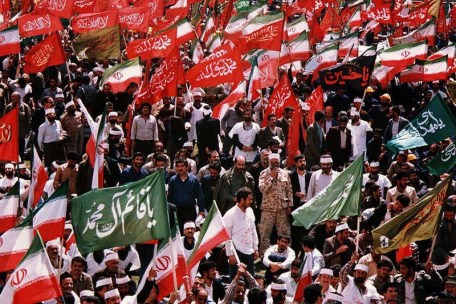Politics of Muharram II: Death to Saddam Yazid, the Disbeliever

By: Mohsen Mazaheri
“Turn the night of attack into the night of Ashoura,
And enunciate the name of God with a beautiful melody,
Enforce Quran’s verdict today,
And reveal the enemy’s plot for the world,
…
Face towards the shrine of your master Hussein,
And mount anew an attack; o comrades!”
- Noted epic sung by Gholam Kuwaitipour
Not only did the Islamic Revolution change the political regime ruling Iran, but also it compelled other social institutions-- including the mourning congregations-- to choose between two options: either adapt themselves to the new trend, or face marginalization. The radical strand of the revolutionary youth called for a transformation in both form and content of the ceremonies. There were even calls for bringing the religious congregations under the control of newly-established revolutionary institutions such as the Islamic Development Organization, though such demands faced Ayatollah Khomeini’s opposition, who insisted on traditional congregations sustaining their activities.
The pro-transformation revolutionaries thus decided to run their own congregations, which differed in organizational structure, theme, audience, language and even the style of maddahi from their traditional counterparts. In terms of function, these congregations were also calibrated to the cause of the Islamic Revolution. The ‘revolutionary congregations’ played a crucial role during the “Imposed War”, i.e. the 8-year war between Iraq (under the rule of Saddam Hussein) and Iran.
Jihad and martyrdom, the cornerstones of Ashoura, turned into the conceptual mainstays of revolutionary congregations held in the battle front of a war driven by an insuppressibly ideological contradiction. A new analogy had to emerge, and it did, as chants of “Death to Saddam, Yazid the Disbeliever” and “Karbala! Karbala! we are coming toward you” evince. For Iranians, the battle front was another Karbala (site of Imam Hussein’s martyrdom), and they were following him, fighting against Saddam, the Yazid of the age. Names of the Iranian military operations were inspired by Ashoura (e.g. operations Karbala I & II), as were the operations’ code words (e.g. Ya Hossein!). What added to the zeal of the Iranian soldiers was the fact that the Iraqi tyrant was keeping in his control sacred Shi’a pilgrimage sites, namely the cities of Najaf, Karbala and Samarra, where lie the body of several Shi’a imams.
Besides the typical functions, the revolutionary congregations were a place to deliver political analyses, to promote Ayatollah Khomeini’s doctrines, and to inculcate self-purification. In terms of style, due to its potential to boost the spirit of jihad in the path of Allah, noaheh (1) became the most common form of narrating the proceedings of Ashoura. The lyrics were customized for the audience, such as embedding military terminology (e.g. words such as trench, battle front, boots and cartridge belt). Notably, unlike their traditional rivals, the revolutionary congregations did not limit themselves to certain times and locations to hold their mourning ceremonies. Soldiers gathered to commemorate the Ashoura not only on the anniversary of the event, but also on the nights before the operations. The ceremonies were not exclusively held in the battle fronts, but also in the cities far from the war zone, in order to keep up the soldiers’ revolutionary passion and to attract further volunteers to join the military.
(1) Noaheh is a melancholic rhythmic song sung in Muharram rituals, usually narrating the events of the day of Ashoura and the inner feelings of Imam Hussein and his companions.

